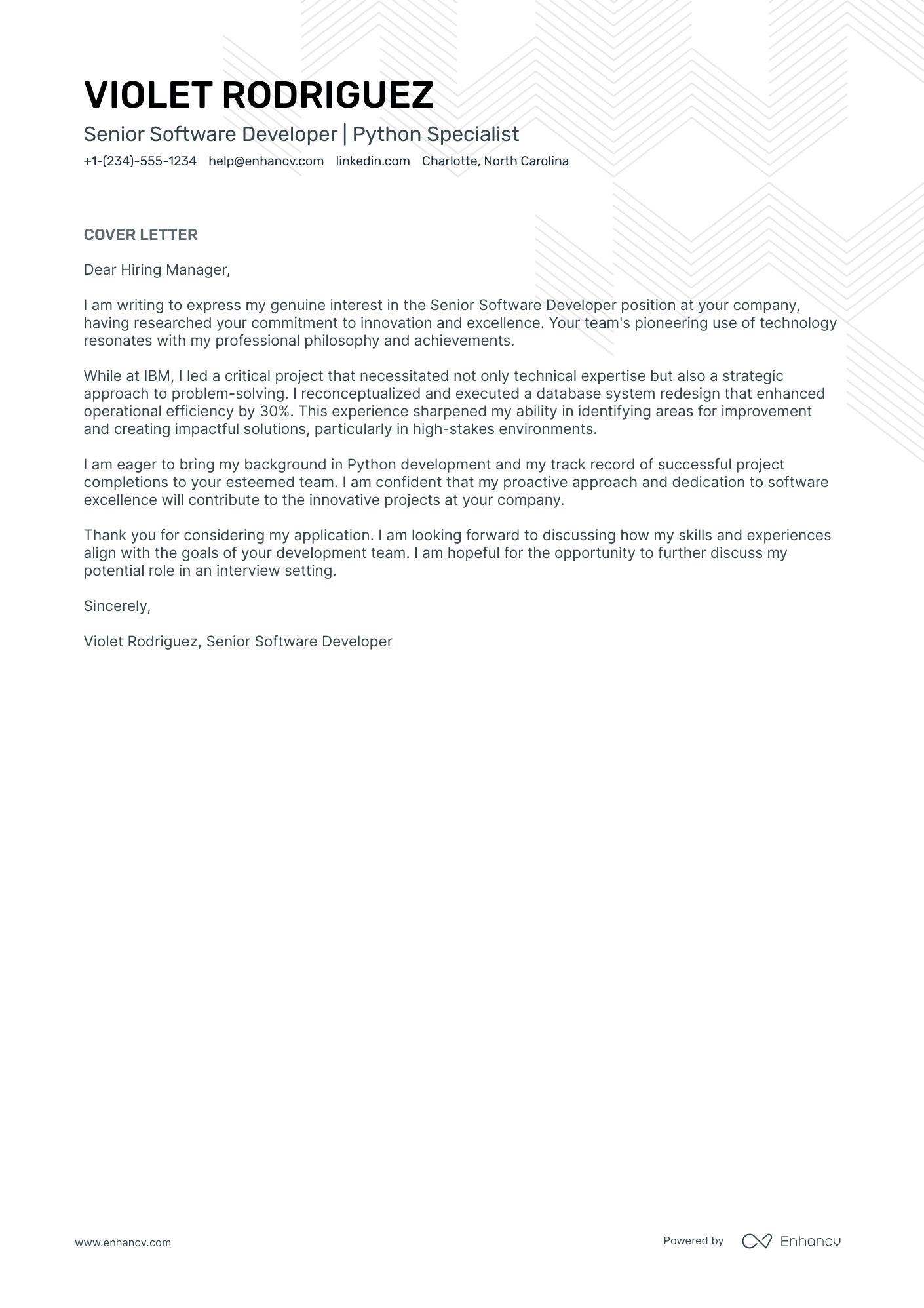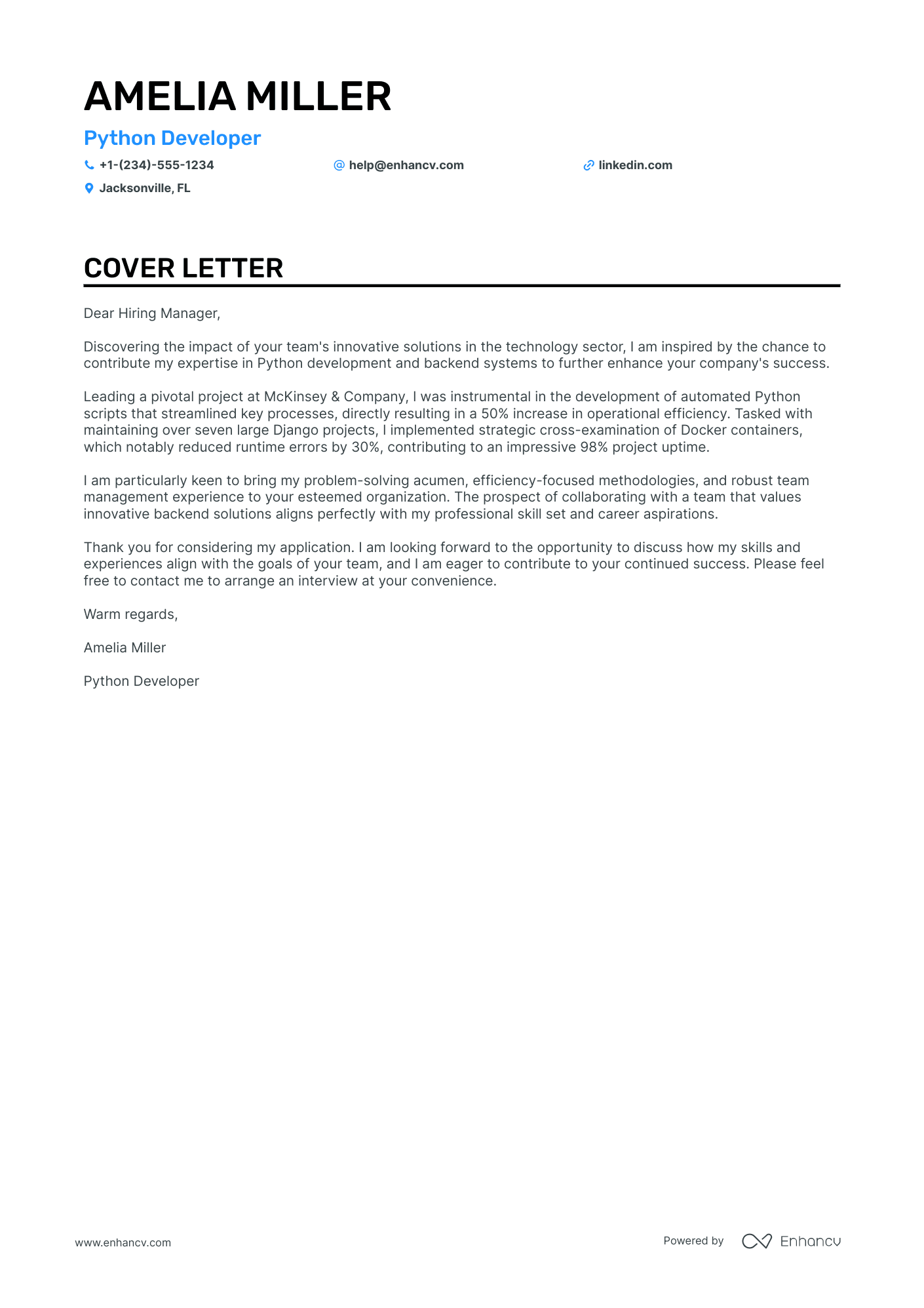Embarking on your job hunt, you’ve hit a common hurdle: crafting a Python developer cover letter that stands out. It's not just about echoing your resume; it’s your chance to weave a compelling story around your proudest professional moment. Striking the perfect balance between formality and originality can be tricky, and the pressure to keep it concise—to one page—adds to the challenge. Let's navigate these waters together and create a cover letter that captures your unique achievements.
- Create a python developer cover letter to persuade the recruiters you're the best candidate for the role;
- Use industry-leading python developer cover letter templates and examples to save time;
- Dedicate your python developer cover letter space to your best achievement;
- Make sure your python developer cover letter meets recruiters' expectations and standards.
Avoid starting at the blank page for hours by using Enhancv's AI - just upload your resume and your python developer cover letter will be ready for you to (tweak and) submit for your dream job.
If the python developer isn't exactly the one you're looking for we have a plethora of cover letter examples for jobs like this one:
Drop your resume here or choose a file.
PDF & DOCX only. Max 2MB file size.
Python developer cover letter example
TIMOTHY DUNCAN
San Francisco, CA
+1-(234)-555-1234
help@enhancv.com
- Demonstrating relevant experience: The cover letter highlights the candidate's previous role at Revolut, showcasing a history of working within the fintech sector which aligns directly with the company's field of expertise.
- Highlighting a key achievement: Mentioning the development of a complex ETL pipeline at Bank of America showcases specific technical abilities and direct, quantifiable success that is relevant to the prospective role.
- Technical skills emphasis: The applicant emphasizes their Python and cloud technology experience, which directly pertains to the required skills listed for the Python Developer position.
- Expressing enthusiasm and fit: The candidate articulates a clear enthusiasm for the company's innovations and a desire to contribute to its ongoing projects, suggesting a good culture and mission fit.
What should your python developer cover letter look like - formatting and organizing your information
Have you ever wondered what are the must-have sections you need to include in your python developer cover letter? Our builder sets those up for you with:
- Header - dedicated to your contact information, the role you're applying for, and the date (don't forget to include your name);
- Greeting and opening paragraph - to create a personalized and memorable experience for recruiters;
- Body paragraph - emphasizing your skill set and knowledge that aligns with the role and helps you to stand out;
- Closing paragraph - leaving a great impression and ending with an optional signature.
Use a cover letter template to discover the best formatting for your python developer cover letter: that is single-spaced paragraphs and wrapping your content in a one-inch margin.
Ensure that both your resume and python developer cover letter are in the same font. Stand apart from the crowd by using modern, yet simple fonts, like Chivo and Rubik, instead of the overused Arial and Times New Roman.
Did you know that the Applicant Tracker System (or ATS) won't be assessing your python developer cover letter? Instead, submit your profile in PDF to recruiters to keep the same formatting and the design intact.
Skip the hassle of writing a cover letter. Use our free cover letter generator and get it done in moments.
The top sections on a python developer cover letter
- Header: Includes your contact information, date, and the employer's contact information, setting a professional tone and providing necessary details for a recruiter to reach you.
- Greeting: A personalized salutation addressing the hiring manager by name demonstrates your attention to detail and interest in the company, which is valuable in development roles where understanding client needs is essential.
- Introduction: Briefly state your interest in the Python developer position, highlighting your passion for programming and problem-solving, to engage the recruiter from the outset.
- Body: Detail your relevant experience, programming skills, and successful projects you've contributed to as evidence of your ability to excel in a Python development role, showing direct applicability to the job requirements.
- Closing: Convey your enthusiasm for the opportunity to contribute to the team, and extend an invitation to discuss your qualifications further, signaling your proactive approach and eagerness to become a part of the company.
Key qualities recruiters search for in a candidate’s cover letter
Proficiency in Python frameworks (such as Django, Flask, or Pyramid): Recruiters look for familiarity with popular frameworks as it indicates the developer can efficiently create and deploy complex web applications.
Experience with object-relational mappers (ORMs): Developers who can effectively utilize ORMs like SQLAlchemy are able to interact with databases more intuitively and write database-agnostic code.
Understanding of front-end technologies (HTML, CSS, JavaScript): While Python developers focus on server-side code, the ability to integrate with and understand the front-end ensures a cohesive end product and aids in full-stack development tasks.
Familiarity with version control tools, especially Git: Strong knowledge of version control is essential for collaborative coding environments, tracking changes, and managing code repositories.
Experience with Python libraries and toolkits (such as NumPy, SciPy for data science, or Pandas for data manipulation): Specialized knowledge in these areas can be crucial for roles that entail data analysis or scientific computing.
Problem-solving skills and algorithmic thinking: Python developers often need to devise logical solutions and understand algorithms to enhance performance and solve complex computational problems.
What greeting should you use in your python developer cover letter salutation
A simple "Hello" or "Hey" just won't work.
With your python developer cover letter salutation, you set the tone of the whole communication.
You should thus address the hiring managers by using their first (or last name) in your greeting.
But how do you find out who's recruiting for the role?
The easiest way is to look up the role on LinkedIn or the corporate website.
Alternatively, you could also contact the organization via social media or email, for more information.
Unable to still obtain the recruiter's name?
Don't go down the "To whom it may concern path". Instead, start your cover letter with a "Dear HR team".
List of salutations you can use
- Dear Hiring Manager,
- Dear [Company Name] Team,
- Dear [Hiring Manager's Name],
- Dear [Department] Department,
- Dear [Mr./Ms. Last Name],
- Dear [Professional Title],
The python developer cover letter introduction: focusing on your unique value, with a creative twist
You are not the only one wondering how to start your python developer cover letter. Those first two sentences introduce your profile and should be memorable.
No pressure.
When beginning your python developer cover letter, immediately point out the unique value of working with you. In other words, what you promise to bring to the role by using your past track record of success.
Start your python developer cover letter with a creative twist by telling a joke or stating something relatable. Select this type of introduction only if it aligns with the company culture.
The middle or body of your python developer cover letter body: a great instrument to tell a story
Now that you've set the right tone with the greeting and introduction of your python developer cover letter, it's time to get down to business.
Hear us out, the body of your python developer cover letter is the best storytelling instrument you have, in your job-hunting arsenal.
Writing the next three to six paragraphs, take the time to reassess the advert to discover job-crucial requirements.
Next, choose one accomplishment that covers those key skills and talents.
Use precisely that achievement to tell an exciting story of how you match the ideal candidate profile.
In the undertones of your story or python developer cover letter body, hint at the difference you'd make and sell your application as the perfect one for the job.
Ending your python developer cover letter to avoid "sincerely yours"
Yes, this sort of closing statement may work best before your signature.
But you want to give recruiters something more with your python developer cover letter ending.
Some professionals choose to go down the path of promises. In a single sentence, they map out what they'd bring about to the role (whether that's a particular technical skill set or personal traits).
Others, decide to be more concrete by thanking recruiters for their time and prompting for their next interview.
Whatever path you choose, remember to always be polite and respectful of the opportunity you've had. Good manners go a long way.
No experience python developer cover letter: making the most out of your profile
Candidates who happen to have no professional experience use their python developer cover letter to stand out.
Instead of focusing on a professional achievement, aim to quantify all the relevant, transferrable skills from your life experience.
Once again, the best practice to do so would be to select an accomplishment - from your whole career history.
Another option would be to plan out your career goals and objectives: how do you see yourself growing, as a professional, in the next five years, thanks to this opportunity?
Be precise and concise about your dreams, and align them with the company vision.
Key takeaways
Winning recruiters over shouldn't be difficult if you use your python developer cover letter to tell a story that:
- Is personalized by greeting your readers and focusing on key job skills greets;
- Isn't spread all over the place, but instead focuses on one key achievement and selling your value as a professional;
- Introduces your enthusiasm for the role, passion for the job, or creativity in communication;
- Is also visually appealing - meeting the best HR practices;
- Ends with a nod to the future and how you envision your growth, as part of the company.
Python Developer cover letter examples
By Experience
Junior Python Developer
Entry Level Python Developer
Senior Python Developer
By Role
Python ETL Developer
Python Django Developer
AWS Python Developer
Python Backend Developer
Python Web Developer
- Specific Project Impact: Highlighting a specific project where the applicant led a team and improved client engagement by 30% underscores proven success and leadership skills. Demonstrating measurable outcomes is crucial for technical positions like a Python Developer.
- Technical Skills and Efficiency: Mentioning the implementation of AWS solutions and a 50% reduction in deployment time emphasizes both technical proficiency and a focus on enhancing efficiency, which are valuable for tech-driven roles.
- Alignment with Company Values: Expressing an interest in contributing to a company that values enhancement and efficiency shows the applicant's research into company culture and objectives, making the appeal more personal and tailored.





















